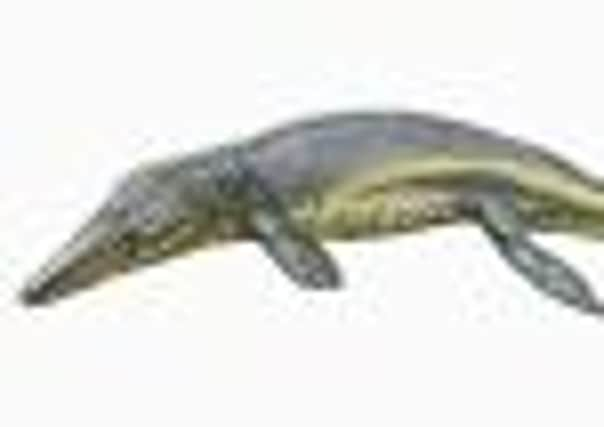New tyrannosaur found by Edinburgh scientists


The animal, which had serrated teeth and a large gaping jaw has been named Tyrannoneustes lythrodectikos, meaning “blood-biting tyrant swimmer”.
These physical characteristics meant the creature would have been suited to feeding on large-bodied prey. The species is the oldest-known member of this group of animals.
Advertisement
Hide AdAdvertisement
Hide AdThe skeleton, which was discovered in the early part of the 20th century, has been sitting in a museum in Glasgow for almost 100 years.
The team of experts examined the partial skeleton – which includes a jawbone about 70 centimetres long and teeth – and say it belongs to a group of crocodiles that were similar to dolphins.
The species, which would have been about four metres long, will help scientists better understand how marine reptiles were evolving about 165 million years ago. It represents a missing link between marine crocodiles that fed on small prey, and others that were similar to modern-day killer whales, which fed on larger prey.
Scientists were able to reach their conclusions by studying the size and shape of the jawbone and teeth, which showed that the animal had a wide gap and shearing bite.
Alfred Leeds, an amateur palaeontologist found the specimen in a clay pit near Peterborough in the early 1900s, and it has since been held by the Hunterian Museum at the University of Glasgow. Dr Mark Young said: “It is satisfying to be able to classify a specimen that has been unexamined for more than 100 years, and doubly so to find that this discovery improves our understanding of the evolution of marine reptiles.
“I examined the bones while doing a research trip to the Hunterian Museum in 2011. After I began to examine them, I realised they belonged to an unknown species.
“After I had looked over the skeleton, and found several unique morphological features, I became quite excited.
I then did a phylogenetic analysis on the specimen [used to try and understand the evolutionary relationships of the new species]. It confirmed that this was indeed a new species.”
Advertisement
Hide AdAdvertisement
Hide AdDr Neil Clark, palaeontology curator at The Hunterian, said: “Little research has been done on this specimen since it was first listed in 1919. It is comforting to know that new species can still be found in museums as new research is carried out on old collections.
“It is not just the new species that are important, but an increase in our understanding of how life evolved and the variety of life forms that existed 163 million years ago in the warm Jurassic seas around what is now Britain.”
Mr Leeds was legendary among palaeontologists for gathering a huge collection of fossil vertebrates from the Middle Jurassic age from the “Oxford Clay” deposits in Peterborough. He went on to amass one of the largest collections in the world.
His wife, Mary Ferrier Fergusson, from Glasgow, often helped him in his work reconstructing the fossils.
On her husband’s death in 1917, she requested his collection be housed in her native city.